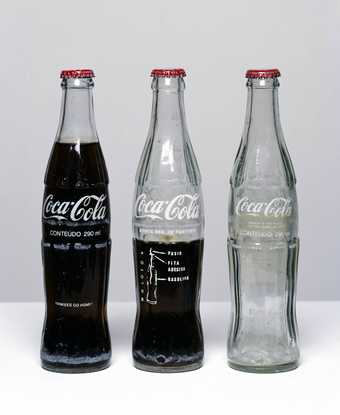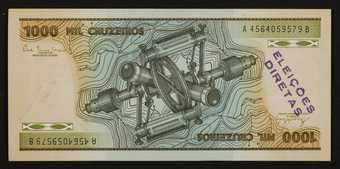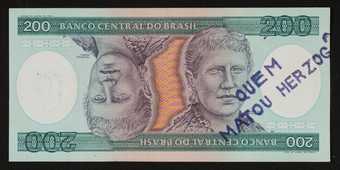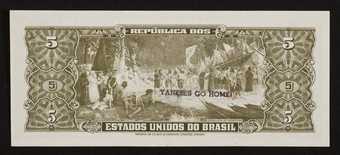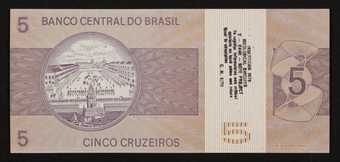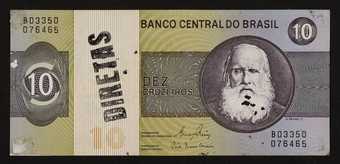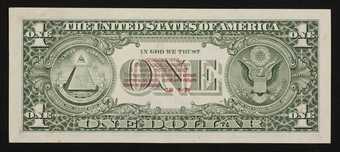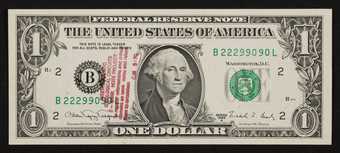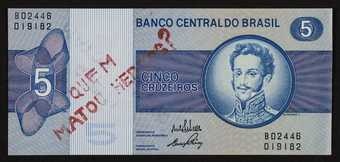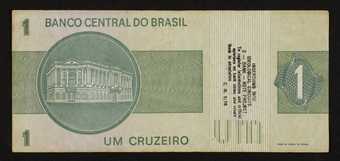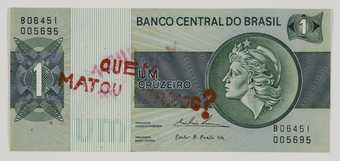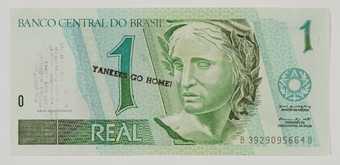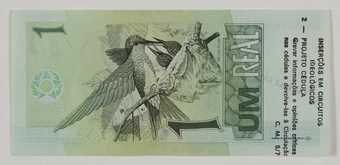
Not on display
- Artist
- Cildo Meireles born 1948
- Medium
- Rubber, wood, fishing nets, metal, paper and audio, 4 channels
- Dimensions
- Display dimensions variable
- Collection
- Tate
- Acquisition
- Presented by the American Fund for the Tate Gallery 2007
- Reference
- T12605
Summary
Eureka/Blindhotland is an installation in a darkened room. In the centre, a spotlight falls dramatically on a large set of scales, raised on a pole. The scales sit in equilibrium, holding in one dish a pair of identical rectangular wooden blocks standing upright in parallel so that they resemble an ‘=’ symbol turned on its end; in the other dish, a pair of the same blocks form an ‘x’ or multiplication symbol. On the floor below, two hundred black rubber balls of the same size are scattered randomly within the confines of a tall net enclosure which defines a square around the central pole. The balls lie on a section of rubber matting the same colour as the pole supporting the scales. Although the balls are identical in appearance, they range in weight between 150 and 1,500 grammes. These physical components form the second part of the work; Eureka referring to the scales and wooden bars, and Blindhotland to the rubber balls. An alternative method of display is to stand the wooden blocks on the floor and balance the accumulated weights of three rubber balls with that of a fourth in the scales. The project’s third component, titled Expeso, is a sound recording that plays in the space. It is a tape-recorded documentation of one hundred balls being dropped from heights in combinations of fixed and variable components: the weights of the balls, the heights from which they are dropped and the distance they are dropped from the microphone. The first part of the project is external to the displayed installation. It involves inserting two basic elements – black and white photographs of a homeless man and of a ball – in between four and eight newspapers on one day during the period of the work’s exhibition. There are eight variations on the way in which the two photographs, in two sizes, may be exhibited, combining size and order. These are described as XY, Xy, xY, xy, YX, yX, Yx, yx.
In a text written for the first exhibition of the work at the Museu de Arte Moderna, Rio de Janeiro, in 1975, the artist explained:
This project is the natural development of an experiment which constitutes, in my view, the basic nucleus of my work. It is an investigation of space in all of its aspects: physical, geometric, historical, psychological, topological and anthropological ... [with] the aim of creating a continuum of perceptual information ... Blindhotland ... is the generic name given to a series of works begun in 1970, in which the dominance of the visual gives way to a ‘blind’ perception of reality through the senses of hearing, smell and taste; through awareness of density, heat, and so on.
(Quoted in Cameron, p.118.)
Eureka/Blindhotland evolved from an initial work, Eureka 1970, that consists simply of a cross made of two wooden bars. Meireles derived the idea for Eureka from Archimedes’ formula for density: density is equal to mass divided by volume (d=m/v). For him, this work demonstrates the possibility of creating a balance between two completely different elements; density becomes a significant physical presence with its own identity. In another work related to the project, Blindhotland/Gueto
(Blindhotland/Ghetto, exhibited at Galerie Luiz Buarque de Hollanda e Paulo Bittencourt, Rio de Janeiro in 1975), viewers were invited to handle eight leather balls in two sizes, four large and four small, containing sand, burlap, air or helium in an area resembling a playing field surrounded by net. As there was no direct relationship between the size and weight of the balls, viewers’ expectations and perceptions of mass and volume were disrupted by interaction with the work.
Meireles belongs to a generation of Brazilian artists who fuse conceptual thinking with a multisensorial approach that prioritises the body. Labelled Neo-Concretism, the movement was founded in the late 1950s by Lygia Clark (1920-88) and Lydia Pape (1929-2004) and extended in the 1960s to include Hélio Oiticica (1937-80). Meireles’s work deals with physical, symbolic and economic energies as condensed forces. Eureka/Blindhotland has two main sources: Jorge Luis Borges’ short story Tlön, Uqbar, Orbis Tertius, 1940, a philosophical fiction playing on the ways in which ideas influence reality; and the scientific theory of black holes. It also relates to Meireles’s experiences of ghetto situations when he was living in Manhattan in the early 1970s. He observed that white residents segregated themselves from their black neighbours, reversing the original ghetto dynamic as they eventually limited their own freedom while black residents were able to circulate more freely. Meireles sees the ghetto as a place of dense information, where under the pressure of being contained, ideas are generated and circulated internally.
Further reading:
Dan Cameron, Paulo Herkenhoff and Gerardo Mosquera, Cildo Meireles, London 1999, pp.23-4, 66-9 and 118-27, reproduced pp.68 and 122-4 in colour.
Cildo Meireles, exhibition catalogue, IVAM Centre del Carme, Valencia 1995.
Felicity Lunn, Vivências: Dialogues between the words of Brazilian artists from 1960s-2002, exhibition catalogue, New Art Gallery, Walsall 2002, reproduced p.42 in colour.
Elizabeth Manchester
September 2006
Does this text contain inaccurate information or language that you feel we should improve or change? We would like to hear from you.
Explore
- emotions, concepts and ideas(16,416)
-
- formal qualities(12,454)
-
- sound(28)
- clothing and personal items(5,879)
-
- net(18)
- light, spotlight(21)
- scales(31)
- ball(50)
- education, science and learning(1,416)
-
- anthropology(11)
- mathematics, Archimedes(1)
- psychology(176)
- contemporary society(640)
- race(381)
- inscriptions(6,664)
You might like
-
Cildo Meireles Insertions into Ideological Circuits: Coca-Cola Project
1970 -
Cildo Meireles Insertions into Ideological Circuits 2: Banknote Project
1970 -
Cildo Meireles Insertions into Ideological Circuits 2: Banknote Project
1970 -
Cildo Meireles Insertions into Ideological Circuits 2: Banknote Project
1970 -
Cildo Meireles Insertions into Ideological Circuits 2: Banknote Project
1970 -
Cildo Meireles Insertions into Ideological Circuits 2: Banknote Project
1970 -
Cildo Meireles Insertions into Ideological Circuits 2: Banknote Project
1970 -
Cildo Meireles Insertions into Ideological Circuits 2: Banknote Project
1970 -
Cildo Meireles Insertions into Ideological Circuits 2: Banknote Project
1970 -
Cildo Meireles Insertions into Ideological Circuits 2: Banknote Project
1970 -
Cildo Meireles Insertions into Ideological Circuits 2: Banknote Project
1970 -
Cildo Meireles Insertions into Ideological Circuits 2: Banknote Project
1970 -
Cildo Meireles Insertions into Ideological Circuits 2: Banknote Project
1970 -
Cildo Meireles Insertions into Ideological Circuits 2: Banknote Project
1970 -
Cildo Meireles Insertions into Ideological Circuits 2: Banknote Project
1970

